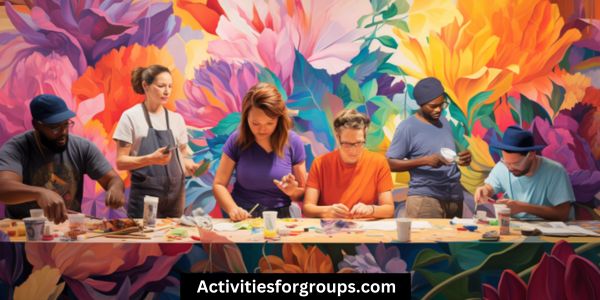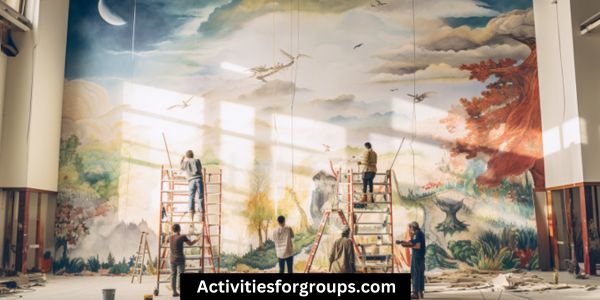Are you looking for an easy way to give back to your community? Organizing a successful group art project for a charity event is a great way to do just that.
You’ll need to determine goals, plan ahead, gather supplies, involve volunteers, and monitor progress.

With some preparation and effort, you’ll be amazed at what you can accomplish!
Determine Goals
Before diving into planning, you need to decide what goals to set for your group art project. Creative brainstorming is key to ensure that everyone’s ideas are considered and that the project is as successful as possible. You should consider both the creative and fundraising goals you have in mind and then use those goals to guide the project.
To start, think about how your project can help to raise money for the charity event. Is the project a piece of art that will be sold for a set price? Or, will it be an interactive project that participants must pay to take part in?
You should also consider the creative aspects of the project. What types of art will be used and how will they be incorporated into the project? What themes will the art project explore?
Once you have an idea of the goals you want to achieve, it’s time to start planning. Develop a timeline that includes the necessary steps to complete the project and ensure that everyone is on the same page. Remember to be flexible and open to changes so that you can maximize your fundraising potential and create an enjoyable project for all involved.
Plan Ahead
Once you have determined the goals of your project, it’s important to plan ahead to ensure that everything runs smoothly. Brainstorm ideas with the team and come up with a plan of action. It’s beneficial to set expectations and document the responsibilities of each team member.
To make sure the project runs smoothly, here are some tips to keep in mind:
- Secure funding: This is one of the most important steps to plan ahead. Make sure to get the necessary funds for the project so that you can complete it to the best of your ability.
- Brainstorm ideas: Come up with creative ideas and ways to execute them. Brainstorming as a team can help to ensure that all ideas are heard and taken into consideration.
- Set expectations: Make sure everyone is on the same page and knows what’s expected of them. Document the team’s responsibilities and make sure everyone is communicating well.
Gather Supplies

Gather the supplies you’ll need for your art project to get started. Depending on your project, you may need canvases, paint, markers, brushes, and other art supplies.
Engage sponsors who may be able to provide donations of supplies or monetary support.
Brainstorm ideas with your group to decide what supplies are necessary and which are optional.
Have a plan for how to use the supplies and how to keep track of them.
Create a list of supplies and assign someone to be in charge of collecting items and purchasing any missing supplies.
Consider asking for donations from local businesses or holding a fundraiser to fund the project. Gather the supplies ahead of time so that your group is ready to get to work on the day of the event.
Have a system for storing the supplies and keeping track of them during the project. Have a backup plan in case any of the materials are lost or damaged.
Make sure everyone has access to the supplies they need to create the art.
Involve Volunteers
Next, enlist the help of volunteers to make your art project a success. Having enough volunteers on-hand is essential to the success of any group art project. To make the best use of volunteers, it’s important to assign roles and delegate tasks.
Here are some tips on how to effectively involve volunteers in your project:
- Clearly communicate the project’s goals and expectations to all volunteers.
- Assign roles that match volunteers’ strengths and interests.
- Delegate tasks to volunteers in an organized and timely manner.
- Create a schedule and provide regular updates to the volunteers.
- Show appreciation for the volunteers’ contribution to your project.
Make sure to be mindful of the volunteers’ needs. Don’t place too much strain on any single volunteer; instead, consider sharing responsibilities. It’s also important to ensure that the volunteers are aware of where to find help if they need it.
With the right volunteers and a well-organized plan, you can make your group art project a success.
Monitor Progress

Now that you have your volunteers in place, it’s time to monitor progress on your group art project. To ensure the project is successful, finding mentors and assigning roles is essential. Mentors can offer guidance to volunteers to ensure the project stays on track.
Assigning roles to volunteers ensures each person knows exactly what’s expected of them and helps to foster a sense of responsibility. When assigning roles, make sure volunteers have the resources they need to complete their tasks.
You should also create a timeline for the project and make sure volunteers are aware of the timeline and deadlines.
This will help keep volunteers on track and will ensure the project is completed on time. In addition, be sure to check in with volunteers regularly to ensure they’re progressing according to the timeline. If you notice any delays, work with the volunteers to find solutions.
Frequently Asked Questions
What Type of Charity Event Should the Art Project Be Tailored To?
You should tailor the art project to a charity event that can benefit from creative fundraising strategies. Consider the type of art selection that fits the event and will resonate with its supporters.
What Art Mediums Should Be Used for the Project?
When selecting materials for the art project, consider what volunteers can easily find and use. Choose mediums that are accessible and suitable for a variety of skill levels.
What Methods Can Be Used to Ensure the Project Stays Within Budget?
Plan ahead and set limits to ensure staying within budget. Make a list of expenses, determine a budget, and stick to it.
How Can the Project Be Promoted to Potential Donors?
Promote your project to potential donors through social media and crowdfunding platforms. Share your story and show how your project will make a difference.
How Can the Group Protect the Artwork From Weather or Other Environmental Factors?
Think of ideas for displaying artwork outdoors ahead of time and plan a timeline that allows for inclement weather. Consider a tent, awning, or covering to protect artwork from any elements.
Conclusion
You’ve done it! With a little planning and some extra help, you’ve organized a successful group art project for a charity event.
You can now be proud knowing you’ve made a positive impact and helped a great cause.
Don’t forget to thank everyone who contributed. You couldn’t have done it without them!




Leave a Reply